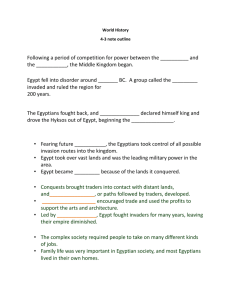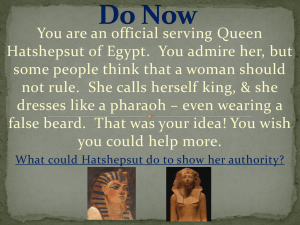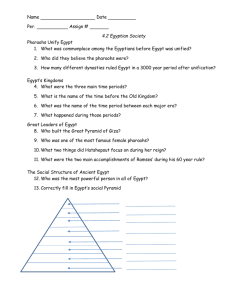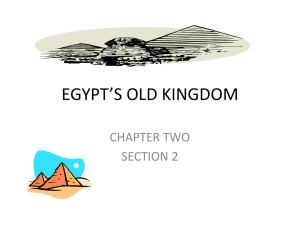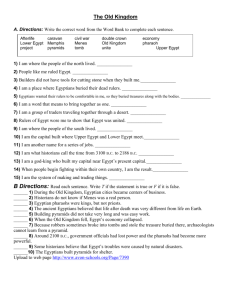SECTION 3 TEXT egypt
advertisement
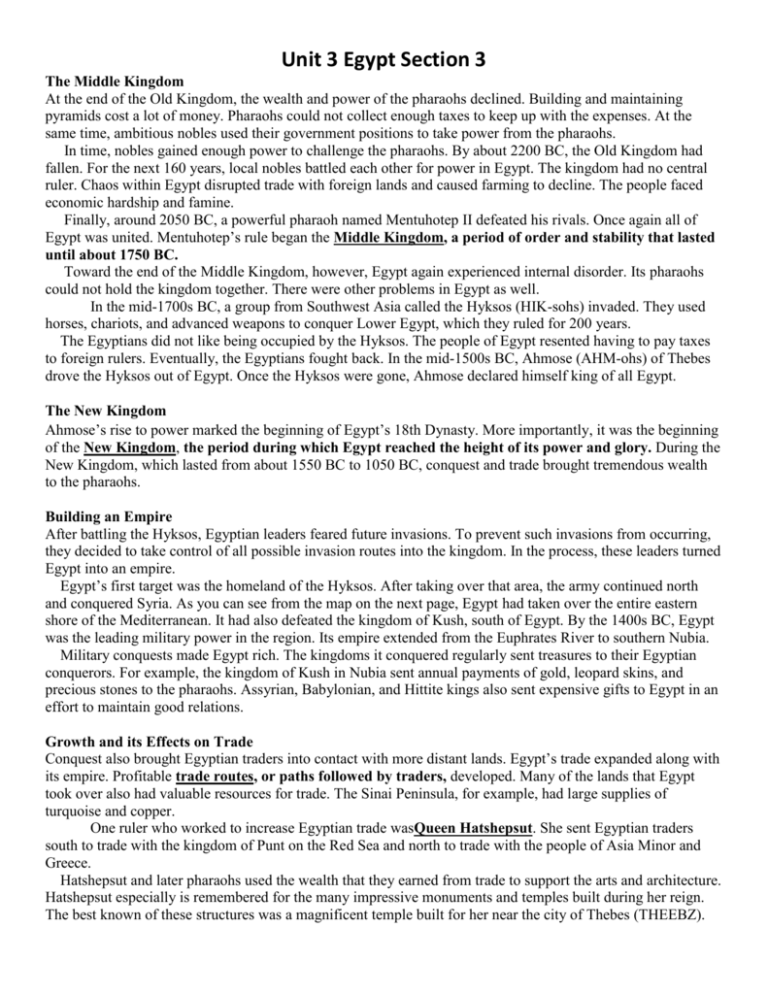
Unit 3 Egypt Section 3 The Middle Kingdom At the end of the Old Kingdom, the wealth and power of the pharaohs declined. Building and maintaining pyramids cost a lot of money. Pharaohs could not collect enough taxes to keep up with the expenses. At the same time, ambitious nobles used their government positions to take power from the pharaohs. In time, nobles gained enough power to challenge the pharaohs. By about 2200 BC, the Old Kingdom had fallen. For the next 160 years, local nobles battled each other for power in Egypt. The kingdom had no central ruler. Chaos within Egypt disrupted trade with foreign lands and caused farming to decline. The people faced economic hardship and famine. Finally, around 2050 BC, a powerful pharaoh named Mentuhotep II defeated his rivals. Once again all of Egypt was united. Mentuhotep’s rule began the Middle Kingdom, a period of order and stability that lasted until about 1750 BC. Toward the end of the Middle Kingdom, however, Egypt again experienced internal disorder. Its pharaohs could not hold the kingdom together. There were other problems in Egypt as well. In the mid-1700s BC, a group from Southwest Asia called the Hyksos (HIK-sohs) invaded. They used horses, chariots, and advanced weapons to conquer Lower Egypt, which they ruled for 200 years. The Egyptians did not like being occupied by the Hyksos. The people of Egypt resented having to pay taxes to foreign rulers. Eventually, the Egyptians fought back. In the mid-1500s BC, Ahmose (AHM-ohs) of Thebes drove the Hyksos out of Egypt. Once the Hyksos were gone, Ahmose declared himself king of all Egypt. The New Kingdom Ahmose’s rise to power marked the beginning of Egypt’s 18th Dynasty. More importantly, it was the beginning of the New Kingdom, the period during which Egypt reached the height of its power and glory. During the New Kingdom, which lasted from about 1550 BC to 1050 BC, conquest and trade brought tremendous wealth to the pharaohs. Building an Empire After battling the Hyksos, Egyptian leaders feared future invasions. To prevent such invasions from occurring, they decided to take control of all possible invasion routes into the kingdom. In the process, these leaders turned Egypt into an empire. Egypt’s first target was the homeland of the Hyksos. After taking over that area, the army continued north and conquered Syria. As you can see from the map on the next page, Egypt had taken over the entire eastern shore of the Mediterranean. It had also defeated the kingdom of Kush, south of Egypt. By the 1400s BC, Egypt was the leading military power in the region. Its empire extended from the Euphrates River to southern Nubia. Military conquests made Egypt rich. The kingdoms it conquered regularly sent treasures to their Egyptian conquerors. For example, the kingdom of Kush in Nubia sent annual payments of gold, leopard skins, and precious stones to the pharaohs. Assyrian, Babylonian, and Hittite kings also sent expensive gifts to Egypt in an effort to maintain good relations. Growth and its Effects on Trade Conquest also brought Egyptian traders into contact with more distant lands. Egypt’s trade expanded along with its empire. Profitable trade routes, or paths followed by traders, developed. Many of the lands that Egypt took over also had valuable resources for trade. The Sinai Peninsula, for example, had large supplies of turquoise and copper. One ruler who worked to increase Egyptian trade wasQueen Hatshepsut. She sent Egyptian traders south to trade with the kingdom of Punt on the Red Sea and north to trade with the people of Asia Minor and Greece. Hatshepsut and later pharaohs used the wealth that they earned from trade to support the arts and architecture. Hatshepsut especially is remembered for the many impressive monuments and temples built during her reign. The best known of these structures was a magnificent temple built for her near the city of Thebes (THEEBZ). Unit 3 Egypt Section 3 Invasions of Egypt Despite its great successes, Egypt’s military might did not go unchallenged. In the 1200s BC the pharaoh Ramses (RAM-seez) II, orRamses the Great, came to power. Ramses, whose reign was one of the longest in Egyptian history, fought the Hittites, a group from Asia Minor. The two powers fought fiercely for years, but neither could defeat the other. Ramses and the Hittite leader eventually signed a peace treaty. Afterwards, the Egyptians and the Hittites became allies. Egypt faced threats in other parts of its empire as well. To the west, a people known as the Tehenu invaded the Nile Delta. Ramses fought them off and built a series of forts to strengthen the western frontier. This proved to be a wise decision because the Tehenu invaded again a century later. Faced with Egypt’s strengthened defenses, however, the Tehenu were defeated once more. Soon after Ramses the Great died, invaders called the Sea Peoples sailed into southwest Asia. Little is known about these people. Historians are not even sure who they were. All we know is that they were strong warriors who had crushed the Hittites and destroyed cities in southwest Asia. Only after 50 years of fighting were the Egyptians able to turn them back. Egypt survived, but its empire in Asia was gone. Shortly after the invasions of the Hittites and the Sea Peoples, the New Kingdom came to an end. Egypt once again fell into a period of violence and disorder. Egypt would never again regain its power. Work and Daily Life Although Egyptian dynasties rose and fell, daily life for Egyptians did not change very much. But as the population grew, society became more complex. A complex society requires people to take on different jobs. Scribes Other than priests and government officials, no one in Egypt was more honored than scribes. They worked for the government and for temples. Scribes kept records and accounts for the state. They also wrote and copied religious and literary texts. Scribes did not pay taxes, and many became wealthy. Artisans, Artists, and Architects Below scribes on the social scale were artisans whose jobs required advanced skills. Among the artisans who worked in Egypt were sculptors, builders, carpenters, jewelers, metal workers, and leather workers. Most of Egypt’s artisans worked for the government or for temples. They made statues, furniture, jewelry, pottery, footwear, and other items. Architects and artists were also admired in Egypt. Architects designed the temples and royal tombs for which Egypt is famous. Talented architects could rise to become high government officials. Artists, often employed by the state or the temples, produced many different works. Artists often worked in the pharaohs’ tombs painting detailed pictures. Soldiers After the Middle Kingdom, Egypt created a professional army. The military offered a chance to rise in status. Soldiers received land as payment and could keep treasure they captured in war. Those who excelled could be promoted to officer positions. Farmers and Other Peasants Egypt’s farmers and other peasants were toward the bottom of the social scale. They made up the vast majority of Egypt’s population. Peasant farmers used wooden hoes or cow-drawn plows to prepare the land before the Unit 3 Egypt Section 3 Nile flooded. After the floodwaters had drained away, they planted seeds. Farmers worked together to gather the harvest. Farmers had to give crops to the pharaoh as taxes. All peasants, including farmers, were subject to special duty. The pharaoh could demand at any time that people work on projects such as building pyramids, mining gold, or fighting in wars. Slaves The few slaves in Egypt were considered lower than farmers. They worked on farms, on building projects, and in households. Slaves had some legal rights and in some cases could earn their freedom. Family Life in Egypt Most Egyptian families lived in their own homes. Men were expected to marry young so that they could start having children. Most Egyptian women were devoted to their homes and their families. Some, however, had jobs outside the home. A few served as priestesses, and some worked as administrators and artisans. Unlike most women in the ancient world, Egyptian women had certain legal rights. These included the right to own property, makecontracts, and divorce their husbands. Children played with toys, took part in ballgames, and hunted. Most boys and girls received an education. At school they learned morals, writing, math, and sports. At age 14, most boys left school to enter their father’s profession.

